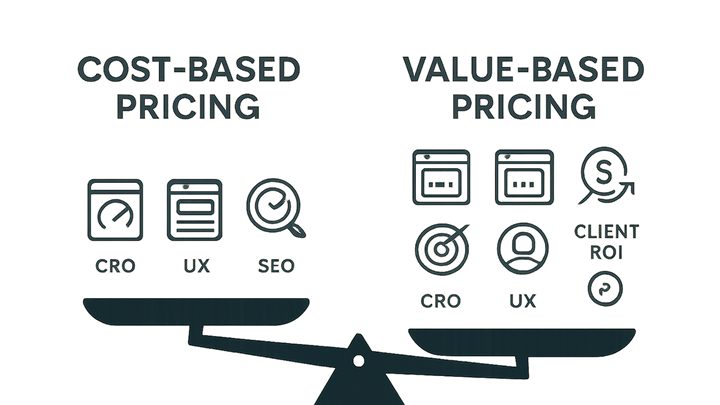Published on 2025-06-29T20:44:23Z
What is Value-Based Pricing? Examples for Website CRO/UX/SEO Critiques
Value-Based Pricing is a strategy where service fees are tied to the perceived or realized value delivered to the client, rather than simply covering costs or applying a fixed markup. In the world of website conversion rate optimization (CRO), user experience (UX), and search engine optimization (SEO) critiques, this approach ensures that consultants and agencies focus on recommendations that drive measurable business outcomes—like increased revenue, improved lead generation, or higher organic traffic. By aligning fees with client goals and potential returns, practitioners can more convincingly communicate ROI, justify project investments, and cultivate long-term partnerships built on shared success.
Implementing value-based pricing involves three key steps: in-depth discovery to understand the client’s objectives and baseline metrics; rigorous analysis to forecast the financial impact of proposed optimizations; and transparent presentation of how critique insights translate into tangible gains. SaaS tools like Prevue.me make this process smoother by delivering actionable CRO, UX, SEO, and accessibility critiques—allowing you to quantify uplift opportunities and craft a compelling value proposition. The result is a pricing model that’s fair, competitive, and intimately aligned with the outcomes that matter most to your clients.
Value-based pricing
A pricing model where fees reflect the client’s perceived value and outcomes from CRO/UX/SEO critiques.
Why Value-Based Pricing Matters in CRO/UX/SEO Critiques
Value-based pricing shifts the conversation from hourly rates or flat fees to the real business impact of your recommendations. This alignment builds trust, differentiates your services, and creates stronger client relationships.
-
Aligning pricing with client outcomes
Tying your fee to metrics like conversion lift or revenue growth ensures both parties are invested in success.
-
Differentiation in a competitive market
Many agencies quote based on hours; value-based pricing positions you as a strategic partner focused on returns.
-
Enhancing client relationships
When clients see you share risk and reward, trust deepens and long-term retainer opportunities increase.
How to Calculate Value-Based Pricing for Website Critiques
Accurate calculation requires a structured approach: identify key KPIs, estimate financial impact, and set a fee that reflects a fair share of projected gains.
-
Identify key performance indicators
Determine metrics that matter most—e.g., conversion rate, average order value, lead form submissions, organic traffic growth.
-
Estimate financial impact
Model potential revenue uplifts by projecting improvements in each KPI.
- Revenue per conversion:
Calculate the average revenue generated per conversion to translate rate lifts into dollars.
- Conversion rate lift:
Estimate the percentage increase in conversions your critique recommendations could achieve.
- Customer lifetime value:
Factor in repeat purchase behavior or subscription renewals for a longer-term value estimate.
- Revenue per conversion:
-
Set your fee as a value share
Propose charging a percentage of the estimated uplift or a fixed fee tiered by impact bands.
Implementing Value-Based Pricing with SaaS Tools like Prevue.me
SaaS platforms can streamline discovery, analysis, and reporting—key phases in setting and justifying a value-based fee.
-
Using prevue.me for actionable cro critiques
Leverage prevue.me’s AI-driven reports to identify high-impact optimization opportunities quickly and quantify potential conversion gains.
-
Integrating ux & seo improvement metrics
Combine prevue.me’s UX and SEO audits to present a holistic view of site health and forecast traffic or engagement gains.
-
Packaging insights into a compelling value proposition
Use generated data tables and projected ROI figures from prevue.me to build a persuasive proposal that ties fees to outcomes.
Pros and Cons of Value-Based Pricing
While value-based pricing can boost client trust and profitability, it also requires rigorous estimation and clear scope management.
-
Pros
Aligns incentives, differentiates services, enhances client relationships.
- Strong roi justification:
Clients see direct correlation between spend and business results.
- Competitive advantage:
Positions you as an outcomes-focused partner, not a commodity.
- Deepened trust:
Sharing risk demonstrates confidence in your work.
- Strong roi justification:
-
Cons
Demanding upfront analysis, potential for underpricing, scope creep risks.
- Complex to calculate:
Requires accurate baseline data and realistic forecasting.
- Risk of underpricing:
Overly optimistic estimates can erode margins.
- Scope creep:
Clients may push for extra recommendations beyond the agreed impact model.
- Complex to calculate:
